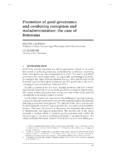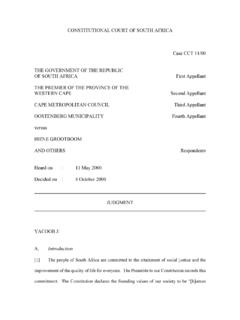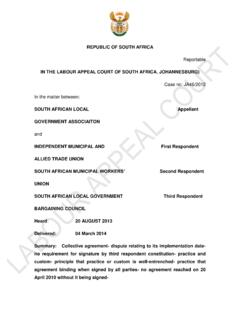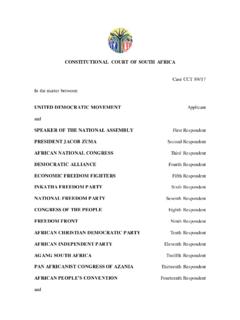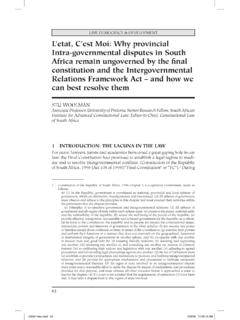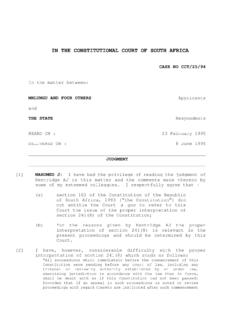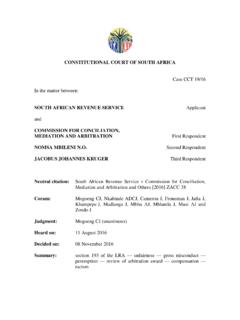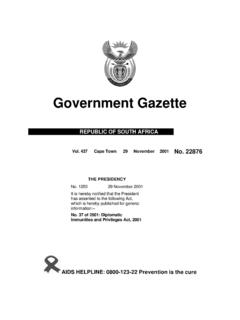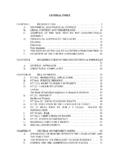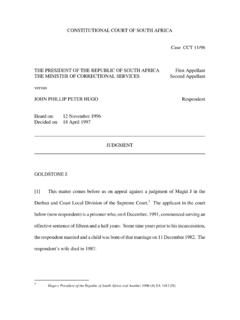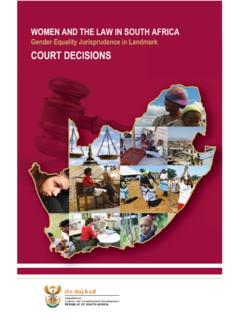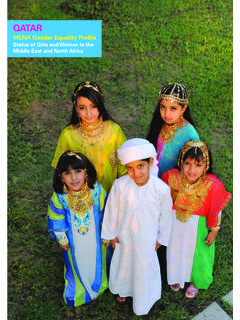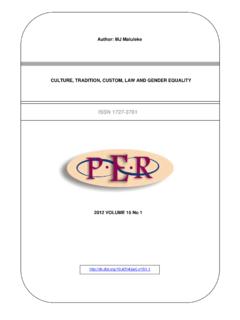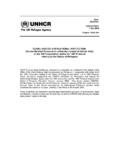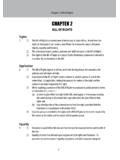Transcription of Case CCT 60/04 MINISTER OF HOME AFFAIRS First …
1 CONSTITUTIONAL COURT OF SOUTH AFRICA Case CCT 60/04 MINISTER OF home AFFAIRS First Applicant DIRECTOR-GENERAL OF home AFFAIRS Second Applicant versus MARI ADRIAANA FOURIE First Respondent CECELIA JOHANNA BONTHUYS Second Respondent with DOCTORS FOR LIFE INTERNATIONAL First amicus curiae JOHN JACKSON SMYTH Second amicus curiae THE MARRIAGE ALLIANCE OF SOUTH AFRICA Third amicus curiae Case CCT 10/05 LESBIAN AND GAY EQUALITY PROJECT AND EIGHTEEN OTHERS Applicants versus MINISTER OF home AFFAIRS First Respondent DIRECTOR-GENERAL OF home AFFAIRS Second Respondent MINISTER OF JUSTICE AND CONSTITUTIONAL DEVELOPMENT Third Respondent Heard on : 17 May 2005 Decided on : 1 December 2005 SACHS J 2 JUDGMENT SACHS J.
2 INTRODUCTION [1] Finding themselves strongly attracted to each other, two people went out regularly and eventually decided to set up home together. After being acknowledged by their friends as a couple for more than a decade, they decided that the time had come to get public recognition and registration of their relationship, and formally to embrace the rights and responsibilities they felt should flow from and attach to it. Like many persons in their situation, they wanted to get married. There was one impediment. They are both women. [2] Ms Mari Adriaana Fourie and Ms Cecelia Johanna Bonthuys are the applicants in the First of two cases1 that were set down for hearing on the same day in this Court.
3 Their complaint has been that the law excludes them from publicly celebrating their love and commitment to each other in marriage. Far from enabling them to regularise their union, it shuts them out, unfairly and unconstitutionally, they claim. 1 MINISTER of home AFFAIRS and Another v Fourie and Another, with Doctors For Life International ( First amicus curiae), John Jackson Smyth (second amicus curiae) and Marriage Alliance of South Africa (third amicus curiae) CCT 60/04 . SACHS J 3[3] They contend that the exclusion comes from the common law definition which states that marriage in South Africa is a union of one man with one woman, to the exclusion, while it lasts, of all others.
4 2 The common law is not self-enforcing, and in order for such a union to be formalised and have legal effect, the provisions of the Marriage Act3 have to be invoked. This, as contended for in the second case,4 is where the further level of exclusion operates. The Marriage Act provides that a MINISTER of religion who is designated as a marriage officer may follow the marriage formula usually observed by the religion In terms of section 30(1) other marriage officers must put to each of the parties the following question: Do you, , declare that as far as you know there is no lawful impediment to your proposed marriage with here present, and that you call all here present to witness that you take as your lawful wife (or husband)?
5 , and thereupon the parties shall give each other the right hand and the marriage officer concerned shall declare the marriage solemnized in the following words: I declare that and here present have been lawfully married. (My emphasis.) The reference to wife (or husband) is said to exclude same-sex couples. It was not disputed by any of the parties that neither the common law nor statute provide for any 2 As articulated by Innes CJ in Mashia Ebrahim v Mahomed Essop 1905 TS 59 at 61. In other cases the exclusion is said to be for life . See for example Hyde v Hyde and Woodmansee 1866 LR 1 P and D 130 at 133; Seedat s Executors v The Master (Natal) 1917 AD 302 at 309 and Ismail v Ismail 1983 (1) SA 1006 (A) at 1019.
6 Given the high degree of divorce this would seem to be a misnomer. 3 Act 25 of 1961. 4 Lesbian and Gay Equality Project and Eighteen Others v MINISTER of home AFFAIRS and Others CCT 10/05. 5 Section 30(1) states in this regard: [A]ny marriage officer designated under section 3 may follow the marriage formula usually observed by his religious denomination or organization if such marriage formula has been approved by the MINISTER .. SACHS J 4legal mechanism in terms of which Ms Fourie and Ms Bonthuys and other same-sex couples could marry. [4] In the pre-democratic era same-sex unions were not only denied any form of legal protection, they were regarded as immoral and their consummation by men could attract Since the interim Constitution came into force in 1994, however, the Bill of Rights has dramatically altered the situation.
7 Section 9(1) of the Constitution now reads: Everyone is equal before the law and has the right to equal protection and benefit of the law. Section 9(3) of the Constitution expressly prohibits unfair discrimination on the grounds of sexual orientation. It reads: The state may not unfairly discriminate directly or indirectly against anyone on one or more grounds, including race, gender, sex, pregnancy, marital status, ethnic or social origin, colour, sexual orientation, age, disability, religion, conscience, belief, culture, language and birth. (My emphasis.) [5] The matter before us accordingly raises the question: does the fact that no provision is made for the applicants, and all those in like situation, to marry each other, amount to denial of equal protection of the law and unfair discrimination by the 6 National Coalition for Gay and Lesbian Equality v MINISTER of Justice 1999 (1) SA 6 (CC); 1998 (12) BCLR 1517 (CC).
8 (The Sodomy case.) SACHS J 5state against them because of their sexual orientation? And if it does, what is the appropriate remedy that this Court should order? I. HISTORY OF THE LITIGATION The First challenge: the common law definition of marriage (the Fourie case) [6] Pursuant to their desire to marry and thereby acquire the status, benefits and responsibilities which traditionally flow from marriage between heterosexual couples, the applicants went to the Pretoria High Court. They asked for an order declaring that the law recognises their right to marry, and a mandamus ordering the MINISTER of home AFFAIRS and the Director-General to register their marriage in terms of the Marriage It will be noted that they did not mount a challenge either to the common law definition of marriage or to the constitutionality of section 30(1) of the Marriage Act.
9 [7] Roux J in the High Court8 attempted to wring out of the parties a clear description of the constitutional issue in the matter. The applicants articulated the issue as follows: Whether the common law has so developed that it can be amended so as to recognise marriages of persons of the same sex as legally valid marriages in terms of the Marriage Act, 25 of 1961 provided that such marriages comply with the formality requisites set out in the Act. 7 They also sought to have their marriage registered in terms of the Identification Act 68 of 1997. 8 Fourie and Another v MINISTER of home AFFAIRS and Another (The Lesbian and Gay Equality Project intervening as amicus curiae), Case No 17280/02, handed down on 18 October 2002.
10 Unreported. SACHS J 6 Roux J concluded that the marriage formula in section 30(1) of the Marriage Act, which contemplates marriage between a male and a female and no other, is peremptory. Consequently the applicants could not be married as required by the law. To compel the MINISTER of home AFFAIRS to register the marriage between the applicants, he added, would constitute a request to do what is unlawful. An omission to challenge the constitutionality of the provisions of the Marriage Act accordingly constituted an obstacle to granting the relief sought. On this basis he dismissed the application. [8] The applicants then applied to the Pretoria High Court for leave to appeal to this Court, alternatively, to the Supreme Court of Appeal (SCA) against his judgment.
